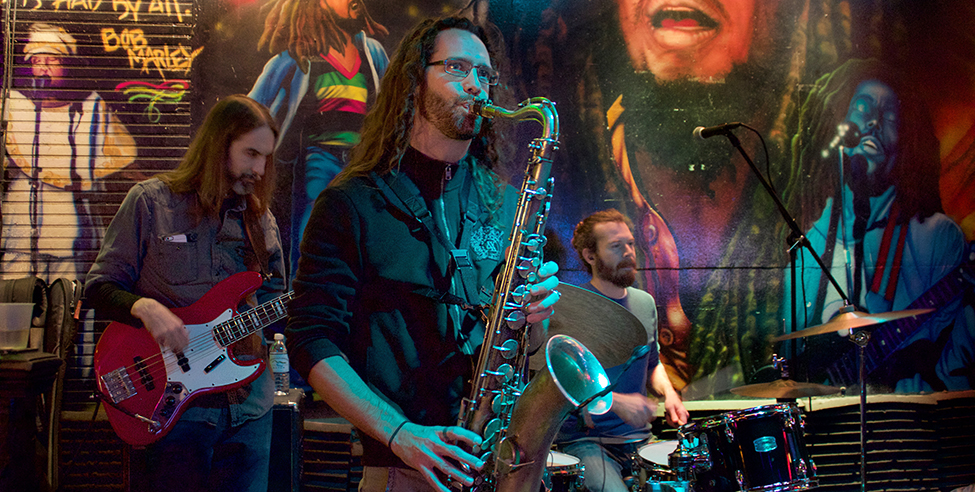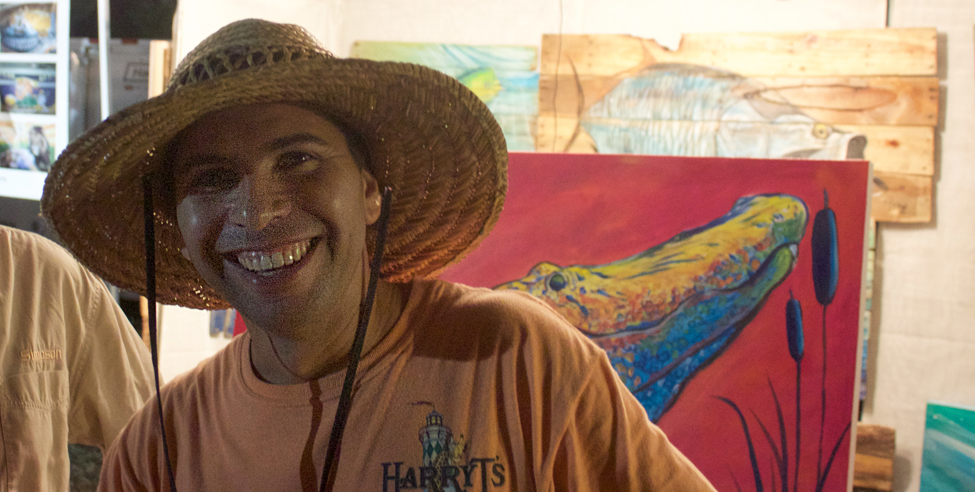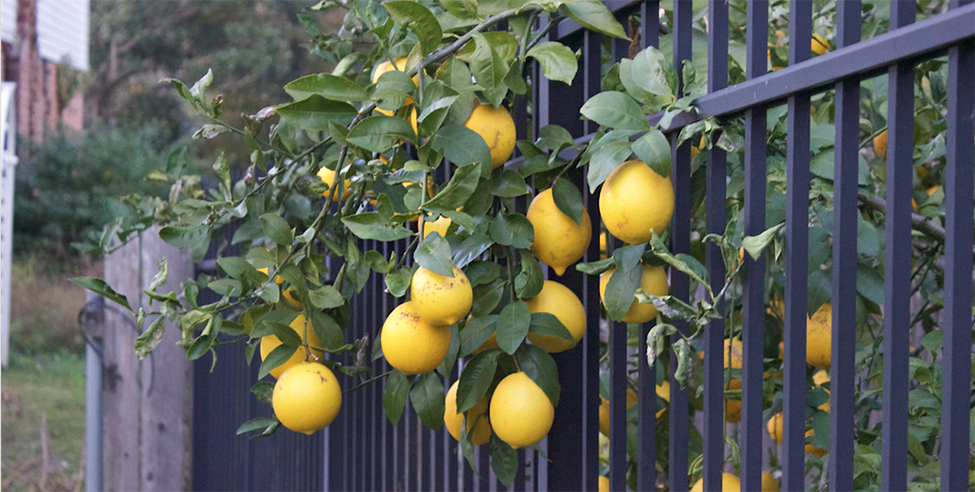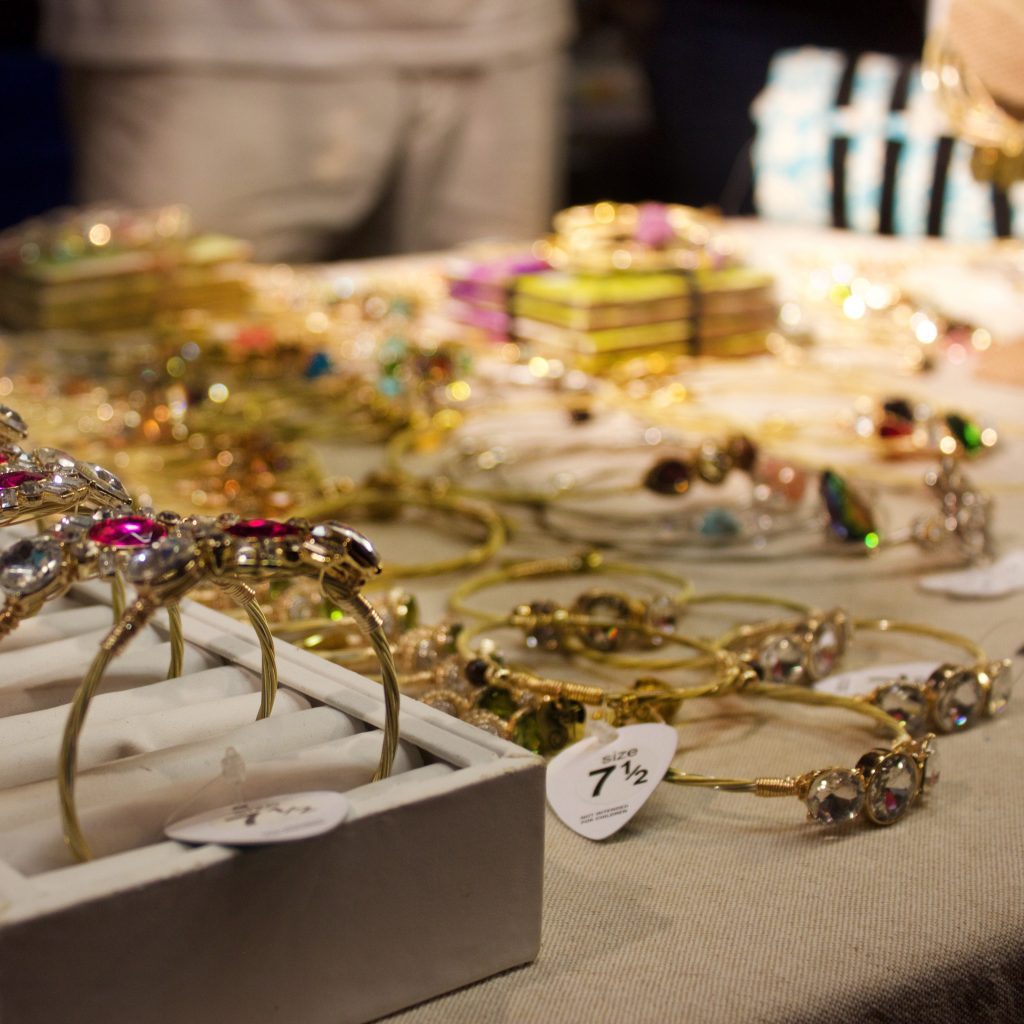You Never Know What You’re Going to get at Louisiana Festivals

by Caroline Callais, Social Media Manager & Web Editor
Music for the Soul // Soul Project NOLA

by Ana Pizzolio, Features Editor New Orleans music is one of the jewels of the south. Inspired by the city’s rich cultural background, Soul Project NOLA has gathered great crowds everywhere they go. The group composed by six musicians has achieved its recognition playing a range of gigs, FROM THE STREETS OF NEW ORLEANS TO THE BIG STAGES OF MUSIC FESTIVALS. “Festivals are all about the interaction with people. It is the energy of New Orleans that drives the place,” key player Jeremy Habegger says. The band songs illustrate the rhythms of New Orleans in a mix of jazz, blues, soul, funk and gospel. “Actually, the gospel today itself has all of those elements. It has the blues. It has the funk. Very much like New Orleans that is not only a blues town,” Habegger explains. They established themselves in New Orleans’s competitive music scene through their songs, and have captivated a fan base with their soulful music. “People down here are truly interested on what kind of music statements you are making,” bass player Scott Jackson says. “We got a supportive crowd and an environment that is conducive to grow and produce new [music].” Soul Project is one of the regular bands to play at Café Negril on Frenchmen Street every Thursday night. “We play up and down Frenchmen street,” Habegger explains. “And we are pretty busy every weekend since we are the folk band of the street.” Soul Project’s festival appearances include the French Quarter Festival, New Orleans Jazz & Heritage Festival, and Jazz In the Park at Armstrong Park. “It is a very different thing doing music festival than to do a stage gig,” Saxophone Player Phil Morin says. “To play festivals in your home town is really nice, to go up there and create music without worrying about working the crowd right to get tips.” Other members of the band not featured in this story are guitarist and lead vocals Jon Cristian Duque, drummer Colin Davis and saxophone player David Ludman. It doesn’t have to be festival season to catch good South Louisiana music, just head to Frenchmen Street and have some fun.
Louisiana Artist Finds Inspiration in the Beauties of the South

by Ana Pizzolio, Features Editor THE RICH WILDLIFE AND UNIQUE SCENERY OF THE SOUTHERN COAST is the main theme in the paintings of Kelly Pierre, an artist native to Houma, Louisiana. Pierre is a 44-year-old artist who saw opportunity in Louisiana’s themed art to launch his career in fine arts painting. He showcased his paintings at the Voice of the Wetlands Festival, where he could be found at a vendor tent working on one his of paintings throughout the night. “The majority of my painting is about coastal wildlife and landscape of the south. This is my inspiration because I grew up in the Gulf of Mexico,” Pierre says. Coming from a family of shrimpers, Pierre started painting the scenes he saw along the gulf of Mexico since he was a child. His career as an artist, however, came much later in life. The artist explains he began to make a living out of his art after he found out about airbrushing. “At that time, becoming a full time painter was just a dream, but I continued working hard until I could afford to make the decision and take the risk going into fine art painting.” Pierre made a promise that he would be prepared to go into the fine arts business if the Saints won the Super Bowl in 2010. He believe the team would win and to help launch his career as an artist he painted a fleur de lis he called “The Black and Gold Dream.” “It was a dream to win the Super Bowl and what I am doing now was a dream to live out my artist career,” Pierre says. “I painted four fleur de lis and put them in an art gallery in New Orleans and after the Saints won I had 130 orders.” Nowadays, Pierre’s art studio is located in Destin Florida. He says that the he has added beach sceneries to his repertoire, but his paintings continue to be heavily influenced by the beauties of the south. He adds that he is a strong supporter of the efforts for the preservation of the wetlands. “I was born and raised in South Louisiana and coastal erosion is a big problem here. There is so much of wildlife and sealife that is born right there, so, as a fishermen, it is hard to see the whole culture disappearing,” Pierre explains. “So we do what we can to educate ourselves and other people to try to protect the barrier islands we have left.”
A Sneak Peek // Louisiana’s Backyard

by Ana Pizzolio, Features Editor Record-breaking hard freezes and hurricanes have directly affected Louisiana’s citrus industry for decades. The persistence of the farmers, support of locals and incentives from the local government is what keeps the production going until today. You can see the community involvement in the promotion of the local citrus crop at the annual PLAQUEMINES PARISH ORANGE FESTIVAL. This year, the festival took place at the Historic Fort Jackson in Buras from December 3-4, featuring carnival rides, music, a variety of locally produced citrus and fireworks. “I’ve been doing [this festival] my whole life. Some years we didn’t have a booth because of hurricanes and things like that, but we always come back,” Jeremy Becnel, from the Becnel Citrus Company, says. The music line-up featured Big River Band, Aaron Foret and Boot Hill on Saturday, and Ernie Wilkinson & the Hot Sauce Band and Rockin Dopsie on Sunday. Other activities included helicopter rides, a 5k run/walk, a children’s pageant, and contests such as Orange Eating, and Orange Peeling. Since its first edition in 1947, the orange festival is an opportunity for farmers to showcase their produce and for locals to supporting and celebrating the region’s main industry. Considering that the climate best allows the mass production of oranges in restricted areas only, the main crops cultivated for commercial purposes in the state are SATSUMAS AND NAVEL ORANGES. Those two along with tangerines, blood oranges, lemons, and grapefruits are just a small sample of the variety of Louisiana’s citrus produce displayed in the individual vendors’ booths at the festival. “We grow about five varieties of citrus commercially. It is predominantly Satsumas and Navels, but we have a nursery operation in which I grow about 25 varieties of citrus trees in a pot,” Becnel says. The state’s ties with citrus produce is what allows such diversity. In Louisiana, the tradition of cultivating those fruits has gone beyond commercial purposes and now citrus trees can be easily found in backyards of Louisiana’s homes. Take a look at the different citrus trees found along Louisiana’s neighborhoods in Luling, Thibodaux and Napoleonville. Know of a backyard where you can get your hands on some fresh Louisiana citrus? Here’s some lagniappe for you: visit our Chu-Chut page to learn how to make orangecello.
The Po’Boy // A Piece of Louisiana History

by Ana Pizzolio, Features Editor A loaf of french bread split open, filled with meat and dressed properly is not just a sandwich; THE FAMOUS NEW ORLEANS PO’BOY is a piece of Louisiana’s history. The Oak Street Po’boy Festival celebrates the richness of Po’boy sandwiches with lots of music, arts and innovative takes on the traditional food. With more than 30 vendors and 50 different variety of the sandwich, the 10th annual Po’boy Fest happened on Sunday, Oct. 23 at the New Orleans’ Carrollton neighborhood. There are countless legends as to the origin of the Po’boy, but it is believed that the sandwich popularization happened amid the streetcar workers strike of July of 1929. According to the research of University of New Orleans History Professor Michael Mizell-Nelson, the Po’boy was created then by former streetcar operators Bennie and Clovis Martin. To support their fellow coworkers, Martin brothers began making these sandwiches to feed then during the strike. Originally called “POOR BOYS,” the sandwiches consisted mainly of meat and bread. The bread is one of the things that makes a Po’boy special. These sandwiches are usually made on either a six-inch or a footlong crisp French bread and, at the time of its popularization, the more common fillings were comprised of roast beef and fried seafood. Because of the cheap cost of its production, this combination allowed the working class to have a great meal for a great price. With time, variations of the Po’boy began to appear and the dish became popular among both locals and tourists. Today, local restaurants in the state offer Po’boys filled with pretty much every kind of meat, from pulled barbecue pork to soft shell crab and fried chicken. Although each local has a different opinion about the best place to get a Po’boy, all of us agree that every tourist needs to grab a bite of a Po’boy to have a complete experience of South Louisiana’s cuisine. If you aren’t hungry yet, wait until you see the tasty Po’boys we found at the festival in the slideshow above.
Festival // Faves and Fails

by Melanie Cowan, Special Sections Editor WHILE ADVENTURING ACROSS SOUTH LOUISIANA AND COVERING THESE FESTIVALS, we have come across some amazing and not so amazing events that the staff would like to share. These are a compilation of our personal experiences at each festival and are our opinions alone. We rated these festivals on a 0-5 scale with five being the best and zero being the worst for four individual categories: vendors, food, crowds and music. Those scores were then added up for a total overall experience score out of 20 possible points. For each festival scoring a 10 or lower, they were given a “FAIL” label, if the festival scored a total of 11-20, they were given a “FAVE” label. Thibodauxville Thibodaux, LAIn the heartland of “Bayou Country” there lies the city of Thibodaux. The city is small perhaps, but nothing short of cultural and rooted in history. In the center of Thibodaux is downtown, the hub of sorts for larger events. This is where Thibodauxville really shines. The festival kicks off with the Big Boy’s Cook-off where locals can put their best and cherished recipes to the test. Visitors can pay just $5 for all you can enjoy tastes of the contestants’ dishes. They are judged and a winner is chosen at the end of the night. The following day is where the real fun begins. Multiple local bands perform throughout the day and food vendors line the closed-off streets to showcase their southern dishes as well as local businesses who sell their crafts under the shade of a tent for visitors to buy something truly special that they cannot get anywhere else. This year’s Thibodauxville festival had a record breaking weekend with their visitors nearly doubling from 2015. Although the crowds were rather large, the lines leading to food vendors were not as long as was expected. The lines were eliminated pretty quickly and it ran very efficient and smooth. The duck races topped the charts with over 500 entries separated by age group. Over 500 rubber ducks floated along the bayou which was truly a site to see. I will surely be returning to this festival next year, where they plan to make this event an all weekend long affair due to the large turn out this year. Thibodauxville truly captured the culture of the bayou region as well as brought visitors and locals together to celebrate everything and anything at all, just like we Louisianaians are known to do. Voice of the Wetlands Festival Houma, LAThis festival is often easily overlooked, but the Voice of the Wetlands festival is a fun and exciting event that brings to light a really big issue directly effecting south Louisiana. That issue is the disappearing of the state’s wetland ecosystems due to coastal erosion. The festival’s purpose is to educate residents on how they themselves can take small steps to saving Louisiana’s wetlands. It also helps that all of the festival’s proceeds go to the Voice of the Wetlands organization—a non-profit dedicated to the education and fund-raising to benefit the preservation of the wetlands. Although it was a great weekend festival, full of great cultural influence and impressive eats, some visitors criticized the location of the festival and how dark the area was once the sun set. There were not that many street lights or extra lighting whatsoever causing the crowds to get sparse as the night went on. However, the “vowenteers” were very upbeat and made the entire festival run amazingly smooth. From running the silent auction to serving food to directing parking, they were an essential part of why this festival is able to keep running year after year. The highlight of the VOW festival was truly the music acts. They booked over five acts per day which really kept everyone on their feet dancing. This festival is bursting with culture and purpose and, although it’s new location was less than perfect, it truly was an enjoyable experience for all ages and this festival is a true testament to the phrase “it takes a village…” because when a community comes together for a worthy cause, they can accomplish amazing things. Fried Chicken Festival New Orleans, LA The first annual Fried Chicken Festival held in the center of New Orleans, was one of the many events that emerged this year held in Lafayette Square. The parking was not as expensive as the French Quarter which was a personal victory for me personally. Spending over $30 to park in New Orleans on any given day makes my heart fall to my feet. On this particular day, however, I only paid $5 to park all afternoon and a short 5-minute walk to Lafayette Square. The music that was playing at this festival was very animated and got everyone on their feet. The music was heavily jazz influenced which is to be expected in this city and fit this festival to a T. There were over 50 vendors all with different methods and dishes with one common denominator—fried chicken, a holy grail in the south region of the United States. White meat, dark meat, tenders, sandwiches, tacos, you name it were at this popular event. The crowds were tremendous. I visited later in the day hoping the crowds would die down but that was extremely far from the truth. The lines to get fried chicken were so long that I did not even get to eat fried chicken at this festival. Not to mention, that booths that had no line were because they ran out of chicken, which was the case for many vendors. To go along with that, the beverage tent was a one-stop-shop of sorts and was the only place to get any kind of beverage on a hot Louisiana day. Alcoholic and soft drinks as well as water were served under the same tent, in the same line. This caused a long line to wait for a beverage as well. However, once you get up there, the
Festival Royalty // A Louisiana Must

by Melanie Cowan, Special Sections Editor There is a little something special in common with all the festivals in Louisiana which has become a subculture within itself. FESTIVAL PAGEANTRY is truly something to behold because it puts a face to the festival itself. The contestants all have ties to the festival or the region in some way to make them want to compete to represent the place that they hold so dear. The competition is fierce, but at the end of it all, one woman stands tall among the rest. In Louisiana alone, 93 of the 123 fairs and festivals under the Louisiana Association of Fairs and Festivals have queens. Although taking the crown seems like a glamorous job, it comes with a lot of responsibility. It is very common for festival queens to travel around the state all year to promote their festival. That means attending other local festivals and and learn about the region. Although most queens are from the area they represent, it is not necessary. This is the case for Caroline Marcello, a senior at Nicholls State University from Thibodaux and this year’s Sugar Cane Festival Queen 75. This may seem confusing to some, being that Marcello is from Thibodaux but she represents New Iberia at their Sugar Cane Festival but she says it is not about the city itself, but the sugar cane farmers she represents. “In July of this year after an interview process I was asked to serve as Miss Lafourche and represent the sugar cane farmers of the parish at the 75th annual Louisiana Sugar Cane Festival held in New Iberia every September,” Marcello said, “I was completely thrilled when I found out I was going to be representing our great parish and our hard working farmers as well as carrying on a special tradition in my family.” According to Marcello, it was especially important for her to take home the crown because her grandmother served as Queen Sugar 5 many years ago. She wanted to carry on the tradition because pageantry runs in her blood. As Queen Sugar, Marcello has a duty to travel to other festivals and experience what that specific city has to offer. “As a festival queen I get the opportunity to travel across the state of Louisiana and experience the variety of festivals. In my short time of being queen I have already learned so much about the diversity of our state. I’ve tasted gumbo in Bridge city for the Gumbo Festival, pet a cow in Abbeville at the Cattle Festival, and learned how to build a bonfire on the levee in Gramercy at the Festival of the Bonfires. It’s pretty safe to say I wouldn’t have experienced any of these things if I wouldn’t be a festival queen,” Marcello said. The pageant process is a stressful one, some girls have to go through the process year after year to finally get the title. This is the case for Bridge City native, Lyndsey Davis, who currently reigns as Queen Gumbo. Davis went competed in the Miss Gumbo pageant four times before finally winning the title this past September. “I don’t really do pageants, this was the only title I really wanted to compete for because the Gumbo Festival holds such a special place in my heart,” Davis said. Davis’ grandmother founded the Gumbo Festival in 1973 so the festival is a family affair for her. Her grandfather, aunts, uncles, and cousins have all won the crown and this year it is her turn. According to Davis, her reign thus far has been one to remember. “I get to meet so many girls all throughout the state of Louisiana. The duties a queen must uphold is to simply promote her festival with a positive attitude.” Davis says she will most likely not compete for another pageant in the near future because for her, it just would not be the same. “I love what I love and I just stick to it,” Davis said. Although the year is a year full of traveling and memories, it has to come to an end. Each year a festival crowns a new queen, and the queen from the previous year crowns a new successor who will follow in her footsteps. This is what Sydney Poche had to do this year at the Festival of the Bonfires. Her reign ended in November 2016, where she had to crown the new queen. According to Poche, it is just as exciting as her year as queen. “I’m connected to the festival because my parents are on the festival committee. I’ve been building bonfires with my family since I was a baby,” Poche said. She said her reign was a dream come true, but it was time to pass the torch for the next girl. “I’m always going to be there to give advice my successor needs and I will always be Miss Festival of the Bonfires to be there when the festival needs me.” No matter the festival, one thing remains the same, nothing beats the passion and dedication these queens bring to their festivals. Their legacy will live on like the queens before them and will forever be apart of festival culture and history.
First // You Make a Roux…

by Melanie Cowan, Special Sections Editor The start to any good gumbo or bisque is a ROUX— it is sac religious to think otherwise in South Louisiana. A roux is the foundation used to thicken stocks and is most commonly used to make gumbo. Most rouxs start by continuously stirring flour and a type of fat (either butter or oil) to get a desired color. It is, in fact, a labor of love that shines through Cajun dishes and has been an art form of sorts for decades. There are a few ways to make a good roux and most Cajuns will claim their method is better than the next. THE FIRST METHOD is an oil-less way of making a roux in the oven. All that is needed is two cups of all purpose flour. Start by preheating the oven to 350 degrees fahrenheit, then spread the flour evenly along the bottom of a cast iron skillet. Bake, stirring the mixture occasionally for about an hour until the desired color is reached. When the color is reached, let cool on a cookie sheet until needed. ANOTHER TRADITIONAL METHOD of making a roux is the Brown Roux method of mixing ½ cup of flour to ½ cup of butter together in a sauté pan. First melt the butter over medium-high heat. Slowly add flour stirring constantly until flour becomes light brown. The key here is stirring constantly because flour can become easily scorched and the roux will be unusable. If black specks show up in the roux, it is scorched and cannot be used. THE LAST COMMONLY USED METHOD of making a roux is the Oil Base Roux. This recipe calls for 1 cup of vegetable oil to 1 cup of flour. It is prepared the same way as a Brown roux, however, it will taste different. The color of a roux varies greatly as well and it is dependent on what the roux will be used for. A Blonde Butter Roux is cooked to a golden color, a White Butter Roux is cooked to a barley beige color, a Light Brown Cajun Roux which is light brown in color, and a Dark Brown Cajun Roux. A dark brown roux is usually used for gumbo. No matter the color, they are all helpful in the thickening of any Cajun dish that uses stock. Take a look at the video above to learn more on how to make a proper Cajun roux. https://youtu.be/65eKEIAdd1E
Voice of the Wetlands // Putting Louisiana’s Coastal Loss in the Spotlight

by Ana Pizzolio, Features Editor Louisianans love to celebrate — everything from food to music to crops. But what many tourists don’t see is we also hold festivals to raise awareness. THE VOICE OF THE WETLANDS FESTIVAL is one of those festivals that brings attention to how coastal erosion and land loss is affecting Louisiana’s ecosystem. The 2016 VOW, held from October 7 to 9, celebrated South Louisiana’s culture while advocating for environmental awareness. The festival featured local and national performers in two music stages, a taste of typical Louisiana dishes from local vendors and arts exhibits. The music festival is just one of the initiatives created by the namesake organization. In an effort to preserve Louisiana’s environment and its culture, the Houma-based organization promotes activism through three days of festival celebrations every year. “We wanted to raise our voices and address the concerns of the people. We were the first organization to go coast to coast saying our wetlands are disappearing.” Rueben Williams, co-founder of the Voice of the Wetlands organization, says. “We are losing over a football field every 45 minutes.” Tab Benoit, a Louisiana Cajun-blues musician, is the founder of the Voice of the Wetlands organization. The organization is comprised of members who were born, raised and still resides in the wetlands’ region. Williams explains that the organization came to terms after the group realized the wetlands loss was a big problem that wasn’t receiving the attention it should receive. “Coast to coast nobody really knew what was going on,” Williams says. “There was salt water coming in and no fresh water going out and that’s not how it used to be. Fresh water used to travel from the Mississippi down Lafourche and Bayou Terrebonne and deposit sediment that build our wetlands. There is no rebuilding process anymore, because the river has been turned towards the Atchafalaya. If the river was still in its natural state we wouldn’t be having a wetlands problem.” Each year, exhibitors from all over the country and, in some occasions, from foreign countries volunteer their times to share their knowledge about coastal land loss and promote awareness of Louisiana’s wetland crisis. “People from outside Louisiana come and see Louisiana’s worth, all this culture, the food and the music. And all of this is possible because of the wetlands and the people that live here,” Williams says. “Even the music we play has come from this place that we are seeing disappear before our eyes.” This years festival had its largest attendance ever during the first day of the event on Friday, Oct. 7. One of the night’s highlights, the “Friday Night Guitar Fights”, featured freestyle performances from musicians Tab Benoit, Mason Ruffner, Josh Garrett, Tyrone Vaughan, Bart Walker and Jonathon Boogie Long. The festivals offers a taste of Louisiana’s Cajun food with traditional dishes like seafood gumbo, andouille sausage, jambalaya and sauce piquante. A selection of classic American fair food, including hamburgers, hot dogs and more is also offered every year. Along with the musical acts and the traditional food, the Voice of the Wetlands organization had booths set up on the festival grounds to share information about the current situation of the state’s land loss and how people can get involved with the efforts for wetlands restoration. The event is free and, therefore, is not strictly a fundraiser for the Voice of the Wetlands organization. Its main purpose is to educate the visitors about coastal restoration, and, although this is such timely matter, the goal is to create a laid-back venue where visitors have the opportunity to get in contact with environmental agencies and political candidates and discuss potential solutions to the crisis. The festival is more than just another opportunity to party it up, it is also a chance to engage in the cause and help preserve the coast, while listening to local music and having some fun.
Music Pulls the Strings // A Vendor’s Booth

by Ana Pizzolio, Features Editor Music in Louisiana moves more than the tourism industry in the state – it is also the inspiration behind STRING THEORY: GUITAR STRING JEWELRY COMPANY. Amanda Wells is Houma native who created the line of designer jewelry. String Theory’s jewelry are one of a kind designer pieces handmade in Louisiana from guitar strings. Besides the exclusivity of each piece, Louisianians’ love for music made the company a instantaneous success. “Everybody loves music and guitar strings definitely pull at the heartstrings of people,” Wells says. String Theory is a recurrent vendor at the Voice of the Wetlands Festival. Their booth is also a guaranteed presence on several other festivals in the region. Designer pieces from the Louisiana Blues Collection jewelry, made with guitar strings from VOW founder and musician Tad Benoit, raised $700 for the preservation of the wetlands at the festival’s live auction. Wells, who is a former nurse, is married to a local musician Bob Wells and is mother to three musical talented daughters. Before her music-related jewelry line, she was the only one in her family who had no strings with music. Her designer jewelry line reflects a combination of her passion for music, talents and interests. “I decided I need to do something creative,” Wells says. “I was the only one that wasn’t musical, so I just went in the back door of music.” The idea of crafting string jewelry came on a saturday afternoon. Wells found one of her husband’s spare guitar string laying around in her house and, instead of putting it aside in a storage box, she decided to give the strings a new purpose. A couple of strings, some crystals and wire was all she needed to create what came to be the first piece of her jewelry company. After a very positive feedback from her daughters, Wells published a picture of the bracelet on social media. For her surprise, the jewelry was hit and she had dozens of people offering to purchase the piece on the first day. “It is beautiful jewelry that just happens to be made out of guitar strings,” Wells adds. The next step was to create more pieces and put it to the test at Wells’ sister’s gift shop. The jewelry sold quickly and attracted the interest of sales representatives. After that point, the guitar string jewelry rapidly grew from a hobby to a successful entrepreneurship. Currently, Wells’ jewelry is sold in more than 600 stores across the country. With the increasing demand for the handmade pieces, Wells’ middle daughter Hilary decided to join her mom in the pursue of the business venture. The mother-daughter duo are responsible for the design, creation and marketing of all the jewelry. Hillary, who graduated in Mass Communication from Nicholls State University, is also the Public Relations person for the company.
